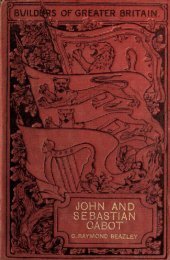st. john of damascus (676-749 - Cristo Raul
st. john of damascus (676-749 - Cristo Raul
st. john of damascus (676-749 - Cristo Raul
Create successful ePaper yourself
Turn your PDF publications into a flip-book with our unique Google optimized e-Paper software.
"<br />
106 ST. JOHN OF DAMASCUS.<br />
holy mountain, towering on high no less by its glory<br />
and splendour than by its cloud-capt l<strong>of</strong>tiness. It<br />
vies with heaven in the grace conferred upon it.<br />
For while in heaven the very angels avail not to gaze<br />
unwaveringly on Chri<strong>st</strong>, here the chosen apo<strong>st</strong>les see<br />
Him shining forth in the glory <strong>of</strong> His kingdom.<br />
On this mountain an assurance is given <strong>of</strong> the resur<br />
rection <strong>of</strong> the dead ;<br />
and Chri<strong>st</strong> is shown to be Lord<br />
both <strong>of</strong> the quick and dead, by bringing<br />
forth as a<br />
witness Moses from the dead, and Elias <strong>st</strong>ill alive,<br />
him who <strong>of</strong> old sped away to the cele<strong>st</strong>ial regions in<br />
his chariot <strong>of</strong> fire" He then<br />
(c. iii.). goes on to<br />
contra<strong>st</strong> Tabor and Sinai. When the law was given<br />
on Sinai, there was cloud and <strong>st</strong>orm and darkness,<br />
all symbols <strong>of</strong> the impenetrable my<strong>st</strong>ery in which the<br />
Divine Giver <strong>of</strong> the law was shrouded. But now, on<br />
Mount Tabor, all is full <strong>of</strong> light and radiance. For<br />
the Son is come from the bosom <strong>of</strong> the Father to<br />
reveal His glory. And His countenance shines as<br />
the sun ; for it beams forth in hypo<strong>st</strong>atic union with<br />
1<br />
immaterial light; and hence He is become the Sun<br />
<strong>of</strong> righteousness. But His garments are white as<br />
meant.<br />
This passage may serve as a specimen <strong>of</strong> the way in which<br />
1<br />
the Greek text <strong>of</strong> Damascenus <strong>st</strong>ill needs revision. The read<br />
ing here is 0wri yap av\(^ raurtfrai KaO vTroaratnv. In a<br />
fragment <strong>of</strong> a Catena on St. Matthew, given later on in the<br />
same volume <strong>of</strong> Migne s edition (col. 1408), it is 0wri yap a\X^&gt;<br />
TavTiZtrai Ka9 vTroaTCHTiv, No one, I suppose, would hesitate<br />
to replace<br />
a\X&lt; in the latter passage by avXy from the former,<br />
while for raim ^trai in both I have ventured to read avyatirai.<br />
Even if ravrterai could have the meaning <strong>of</strong> "is made<br />
identical with,"<br />
that sense is not wanted ;<br />
the following words<br />
sufficiently explaining what kind <strong>of</strong> union is
















